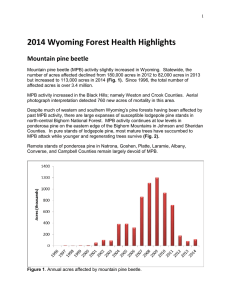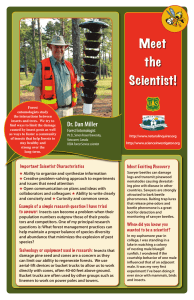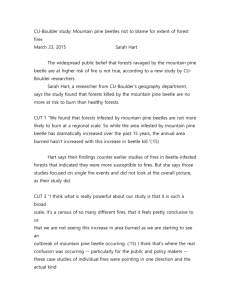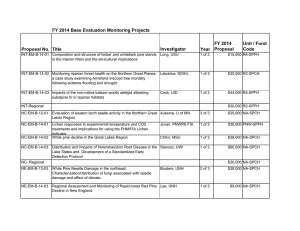Wyoming 2011 Forest Health
advertisement
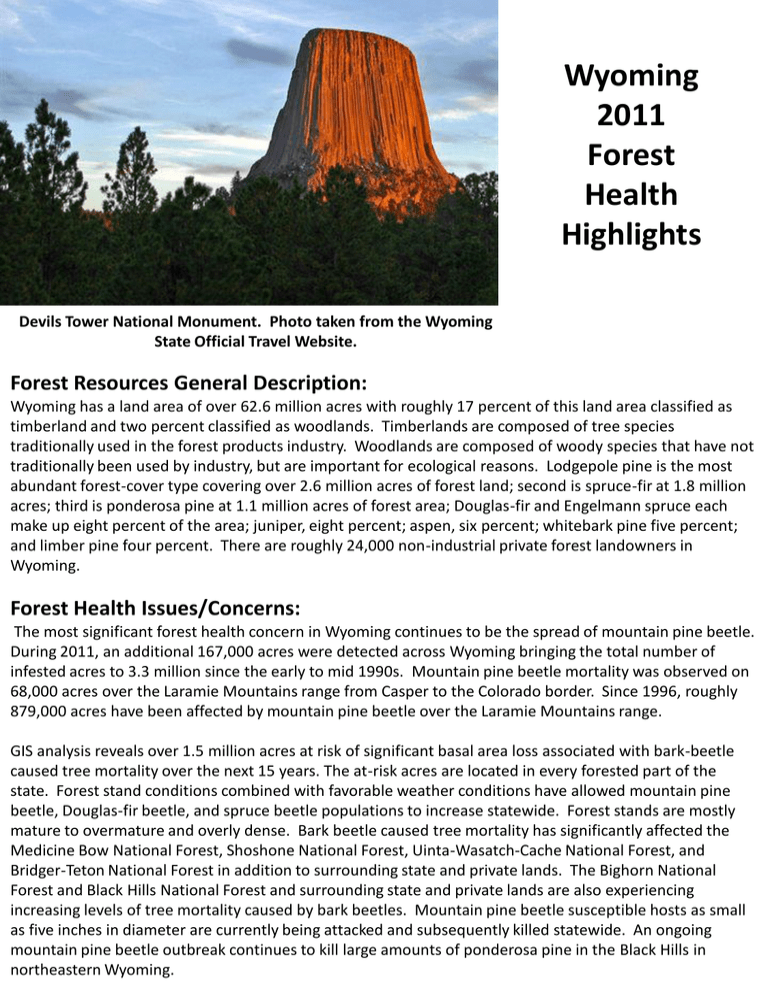
Wyoming 2011 Forest Health Highlights Devils Tower National Monument. Photo taken from the Wyoming State Official Travel Website. Forest Resources General Description: Wyoming has a land area of over 62.6 million acres with roughly 17 percent of this land area classified as timberland and two percent classified as woodlands. Timberlands are composed of tree species traditionally used in the forest products industry. Woodlands are composed of woody species that have not traditionally been used by industry, but are important for ecological reasons. Lodgepole pine is the most abundant forest-cover type covering over 2.6 million acres of forest land; second is spruce-fir at 1.8 million acres; third is ponderosa pine at 1.1 million acres of forest area; Douglas-fir and Engelmann spruce each make up eight percent of the area; juniper, eight percent; aspen, six percent; whitebark pine five percent; and limber pine four percent. There are roughly 24,000 non-industrial private forest landowners in Wyoming. Forest Health Issues/Concerns: The most significant forest health concern in Wyoming continues to be the spread of mountain pine beetle. During 2011, an additional 167,000 acres were detected across Wyoming bringing the total number of infested acres to 3.3 million since the early to mid 1990s. Mountain pine beetle mortality was observed on 68,000 acres over the Laramie Mountains range from Casper to the Colorado border. Since 1996, roughly 879,000 acres have been affected by mountain pine beetle over the Laramie Mountains range. GIS analysis reveals over 1.5 million acres at risk of significant basal area loss associated with bark-beetle caused tree mortality over the next 15 years. The at-risk acres are located in every forested part of the state. Forest stand conditions combined with favorable weather conditions have allowed mountain pine beetle, Douglas-fir beetle, and spruce beetle populations to increase statewide. Forest stands are mostly mature to overmature and overly dense. Bark beetle caused tree mortality has significantly affected the Medicine Bow National Forest, Shoshone National Forest, Uinta-Wasatch-Cache National Forest, and Bridger-Teton National Forest in addition to surrounding state and private lands. The Bighorn National Forest and Black Hills National Forest and surrounding state and private lands are also experiencing increasing levels of tree mortality caused by bark beetles. Mountain pine beetle susceptible hosts as small as five inches in diameter are currently being attacked and subsequently killed statewide. An ongoing mountain pine beetle outbreak continues to kill large amounts of ponderosa pine in the Black Hills in northeastern Wyoming. Limber pine stands statewide are being killed by white pine blister rust and mountain pine beetle particularly in the southern Bighorn Mountain range in northern Natrona County. Whitebark pine and limber pine on the Shoshone National Forest and Bridger-Teton National Forest are also being killed by an expanding mountain pine beetle epidemic as well as the spread of white pine blister rust. Douglas-fir beetle and spruce beetle outbreaks continue to increase in forest stands with sufficient susceptible Douglas-fir and Engelmann spruce. Drought conditions have led to the decline of shallow rooted mature spruce and infestations of Spruce Ips beetle and other detrimental insects in communities around the state. Spruce and pine trees in many communities are experiencing attack from Ips and mountain pine beetle. Due to flight ranges as well as firewood and raw log transport, MPB is now present in many communities. Cheyenne, Rawlins, Torrington, Laramie, Lingle, Fort Laramie, and other communities have reported tree losses from MPB in community parks and private landscapes. New tree mortality caused by mountain pine beetle was detected on 28,000 acres in Yellowstone and Grand Teton National Parks in 2011. Acres with Bark beetle Damages in Wyoming Mountain Pine Beetle in all pines (lodgepole, ponderosa, whitebark, limber) Spruce Beetle Douglas-fir Beetle 2010 2011 933,000 719,000 79,000 76,000 7,400 1,500 Other Damaging Forest Agents in Wyoming: Rusty Tussock Moth, (Orgyia antique) was found defoliating lodgepole pines in Johnson County of the Big Horn Mountains in 2011. Aerial and ground surveys identified the conspicuous defoliation and mortality of lodgepole pine due to an infestation of rusty tussock moth. Rusty Tussock Moth cocoon on lodgepole pine needles Rusty Tussock Moth specimen Root Diseases Found in Wyoming Species Host tree(s) More info: Armillaria cepistipes Hardwoods & Conifers West-central WY A. gallica Oaks & Hardwoods North-east WY A. sinapina Conifers and Hardwoods Widely distributed, but not found in central WY A. solidipes (A.ostoyae) Conifers Most common and found throughout the state Ganoderma applantatum Aspen White mottled rot Coniophora spp. Subalpine Fir Root and butt rot Onnia spp. Englemann Spruce Red root rot Phaelous schweintizii Douglas-fir Root and butt rot These fungal pathogens were found in Wyoming during root disease surveys. Root Diseases continued: Armillaria root disease was seen on oaks along floodplains and in grazed areas in Wyoming. The combination of stresses between flooding in the 1990’s and drought in more recent years promoted its growth in these areas. Four Armillaria species were found at 30% of the locations examined and confirmed to be causing disease 66% of the time. Even though Armillaria root disease was the most common root disease detected, other root diseases were detected during the Wyoming survey. Armillaria spp. fungus on a birch root Birch stand declining because of root disease. For more information on Wyoming Forest Health: Wyoming State Forestry Division 5500 Bishop Boulevard Cheyenne, WY 82002 307-777-7586 http://lands.state.wy.us/ USDA Forest Service - Rocky Mountain Region 740 Simms St. Golden, CO 80401 303-275-5155 www.fs.usda.gov/goto/r2/fh
